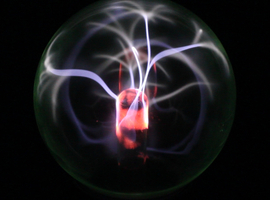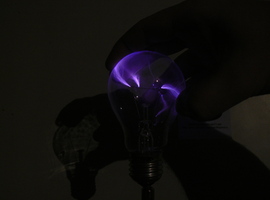Turning a Light Bulb into a Plasma Globe
| Polish version is here |
Captivating Visual Display
A plasma globe is a device designed primarily as a visual novelty. It consists of a glass sphere filled with low-pressure gas, typically a mixture of helium and neon, sometimes with traces of other noble gases. When activated, ribbon-like electric discharges form inside the globe.
Watching the continuously moving, writhing tendrils of electric discharge creates a mesmerizing effect.

The operation of a plasma globe is based on the phenomenon of gas ionization under high voltage. Inside the globe, low pressure allows ionization to occur at relatively low voltages. The globe’s electrode is powered by a high-frequency, low-current AC power supply that generates about 10kV. The result is visually striking electric discharges, with their color depending on the type of gas inside. The discharges rise upward due to convection.
With some basic equipment, you can build an impressive plasma globe at home using the same principles.
DIY Plasma Globe from a Light Bulb
To build your own plasma globe, you need a glass container filled with low-pressure gas. A standard incandescent light bulb meets these conditions, as the inert gas inside the bulb is at sufficiently low pressure to produce bright discharges. For the high-voltage source, you can use a ZVS driver or a Ruhmkorff induction coil. Connect one terminal of the high-voltage source to the bulb’s base, and ground the other terminal.
Warning: Using a ZVS driver or other high-voltage sources is not recommended for beginners without experience handling high voltage. The device output can reach several thousand volts, posing a serious risk of electric shock, which can be hazardous or even fatal. The author assumes no responsibility for any injuries or damages resulting from building or using this device; proceed at your own risk!
When powered on, bright blue discharges become clearly visible inside the bulb. Touching the bulb’s glass causes the discharges to concentrate toward the point of contact. The effect can be seen in the photo and video below:
The discharges also emit a certain amount of ultraviolet radiation.
Enjoy your experiments! :)
Further readings:
- Kordus A., Plazma – właściwości i zastosowanie w technice, Wydawnictwa Naukowo-Techniczne, Warszawa, 1985
- Marcus R.K., Glow Discharge Spectroscopies, Kluwer Academic Publishers, 1993
Marek Ples

